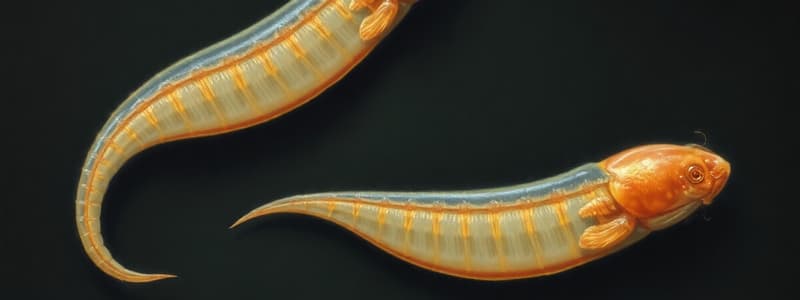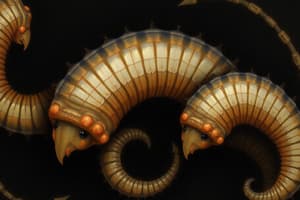Podcast
Questions and Answers
Which of the following is the most critical distinction in the life cycle of Clonorchis sinensis compared to Paragonimus westermani?
Which of the following is the most critical distinction in the life cycle of Clonorchis sinensis compared to Paragonimus westermani?
- _Clonorchis sinensis_ utilizes freshwater fish as a second intermediate host, while _Paragonimus westermani_ uses crabs or crayfish. (correct)
- _Clonorchis sinensis_ eggs are excreted in sputum, whereas _Paragonimus westermani_ eggs are discharged into the bile and stool.
- The definitive host for _Clonorchis sinensis_ is exclusively humans, whereas _Paragonimus westermani_ can only infect canines.
- _Paragonimus westermani_ metacercariae mature in the biliary tract, while _Clonorchis sinensis_ metacercariae mature in the lungs.
Considering the complete life cycle and transmission of both Clonorchis sinensis and Paragonimus westermani, what public health intervention would be MOST effective in reducing the incidence of both infections?
Considering the complete life cycle and transmission of both Clonorchis sinensis and Paragonimus westermani, what public health intervention would be MOST effective in reducing the incidence of both infections?
- Implementing rigorous testing of all freshwater snails to detect and eliminate infected populations.
- Administering prophylactic praziquantel to all individuals in high-risk areas, regardless of consumption habits.
- Promoting thorough cooking of freshwater fish, crabs, and crayfish in endemic regions. (correct)
- Widespread vaccination campaigns targeting reservoir hosts like dogs and cats.
In a scenario where a patient presents with biliary inflammation but denies consuming raw or undercooked freshwater fish, crab, or crayfish, what alternative exposure pathway to Clonorchis sinensis should be MOST thoroughly investigated?
In a scenario where a patient presents with biliary inflammation but denies consuming raw or undercooked freshwater fish, crab, or crayfish, what alternative exposure pathway to Clonorchis sinensis should be MOST thoroughly investigated?
- Consumption of aquatic plants harvested from waters where infected snails reside.
- Cross-contamination in the kitchen where utensils used for raw fish preparation are also used for other foods. (correct)
- Exposure to contaminated soil in agricultural fields where night soil is used as fertilizer.
- Accidental ingestion of water during recreational activities in freshwater bodies.
A researcher aims to develop a novel diagnostic test that can differentiate between Clonorchis sinensis and Paragonimus westermani infections with high specificity. Which biological target would be MOST suitable for this purpose?
A researcher aims to develop a novel diagnostic test that can differentiate between Clonorchis sinensis and Paragonimus westermani infections with high specificity. Which biological target would be MOST suitable for this purpose?
If a patient is diagnosed with a chronic Paragonimus westermani infection localized in the brain, what clinical manifestation would be MOST indicative of this specific parasitic location?
If a patient is diagnosed with a chronic Paragonimus westermani infection localized in the brain, what clinical manifestation would be MOST indicative of this specific parasitic location?
In a region where both Clonorchis sinensis and Paragonimus westermani are endemic, what factor would MOST complicate the epidemiological surveillance efforts aimed at controlling these parasites?
In a region where both Clonorchis sinensis and Paragonimus westermani are endemic, what factor would MOST complicate the epidemiological surveillance efforts aimed at controlling these parasites?
Which of the following statements MOST accurately reflects the difference in disease pathology caused by Clonorchis sinensis versus Paragonimus westermani?
Which of the following statements MOST accurately reflects the difference in disease pathology caused by Clonorchis sinensis versus Paragonimus westermani?
While praziquantel is the recommended treatment for both clonorchiasis and paragonimiasis, what pharmacological principle must be considered when treating a patient with cerebral paragonimiasis compared to a patient with a Clonorchis sinensis infection in the biliary tract?
While praziquantel is the recommended treatment for both clonorchiasis and paragonimiasis, what pharmacological principle must be considered when treating a patient with cerebral paragonimiasis compared to a patient with a Clonorchis sinensis infection in the biliary tract?
In a research study investigating genetic susceptibility to Clonorchis sinensis infection, which approach would provide the MOST insight into host-parasite interactions?
In a research study investigating genetic susceptibility to Clonorchis sinensis infection, which approach would provide the MOST insight into host-parasite interactions?
Considering the parasitic life cycle, what evolutionary adaptation would MOST significantly enhance the survival and transmission success of either Clonorchis sinensis or Paragonimus westermani?
Considering the parasitic life cycle, what evolutionary adaptation would MOST significantly enhance the survival and transmission success of either Clonorchis sinensis or Paragonimus westermani?
Flashcards
Trematodes
Trematodes
Flat, leaf-shaped, unsegmented helminths with oral and ventral suckers.
Clonorchis sinensis
Clonorchis sinensis
The adult flukes reside in small and medium-sized bile ducts causing inflammation
Clonorchis sinensis hosts
Clonorchis sinensis hosts
Humans are the definitive hosts, snails are the first intermediate hosts, and freshwater fish are the second intermediate hosts.
Clonorchiasis
Clonorchiasis
Signup and view all the flashcards
Paragonimus westermani
Paragonimus westermani
Signup and view all the flashcards
Paragonimus westermani hosts
Paragonimus westermani hosts
Signup and view all the flashcards
Paragonimus westermani transmission
Paragonimus westermani transmission
Signup and view all the flashcards
Paragonimiasis
Paragonimiasis
Signup and view all the flashcards
Diagnosis of Trematodes
Diagnosis of Trematodes
Signup and view all the flashcards
Treatment of Trematodes
Treatment of Trematodes
Signup and view all the flashcards
Study Notes
- Trematodes, also known as flukes, are flat, leaf-shaped, unsegmented helminths.
- They have two prominent suckers: oral and ventral.
Life Cycle of Clonorchis sinensis
- Embryonic eggs are released into the bile and stool.
- Snails ingest the eggs, which release miracidia.
- Miracidia develop into cercariae within the snail.
- Cercariae are released from the snail and penetrate freshwater fish.
- Inside fish, cercariae become metacercariae.
- Humans get infected by eating undercooked, salted, pickled, or smoked freshwater fish.
- Metacercariae mature into adult flukes in the duodenum and biliary tract within one month.
- Adult flukes reside in small and medium-sized bile ducts.
Life Cycle of Paragonimus westermani
- Eggs are excreted in sputum or feces.
- Eggs embryonate and hatch into miracidia.
- Snails are the first intermediate host; Larvae undergo several developmental stages within them.
- Cercariae emerge from snails and invade crabs or crayfish, becoming metacercariae.
- Mammalian hosts get infected by metacercariae in crabs or crayfish.
- Humans are infected via inadequately cooked or pickled crab or crayfish.
- Metacercariae excyst in the duodenum, penetrate the intestinal wall, move through the abdominal cavity, diaphragm, and reach the lungs.
- In the lungs, they become encapsulated and mature into adults.
- Adult worms can reach other organs like the brain and striated muscles, but cannot complete their life cycle there.
- Infections can persist for up to 20 years in humans.
- Animals like pigs, dogs, and felines can also harbor Paragonimus spp.
Clonorchis sinensis Details
- Also known as the liver fluke.
- Humans are definitive hosts.
- Dogs and fish-eating canines are reservoir hosts.
- Snails are the first intermediate host.
- Fish are the second intermediate host.
- Exists in adult, egg, and larval stages.
- The infective stage is the metacercaria (larval stage).
- Transmitted by eating undercooked freshwater fish containing larvae.
- Found in the biliary tract and sometimes the pancreatic duct.
- Causes clonorchiasis, which is inflammation of the biliary tract.
Diagnosis and Treatment
- Diagnosed by observing eggs in the stool.
- Treated with praziquantel.
Paragonimus westermani Details
- Called the lung fluke because it resides in the respiratory tract.
- Causes paragonimiasis, which is inflammation and secondary bacterial infection of the lungs.
- Humans are the definitive hosts.
- Freshwater snails are the first intermediate hosts.
- Freshwater crabs or crayfish are the second intermediate hosts.
- Transmitted by eating undercooked crab or crayfish containing metacercarial larvae (infected stage).
Studying That Suits You
Use AI to generate personalized quizzes and flashcards to suit your learning preferences.




